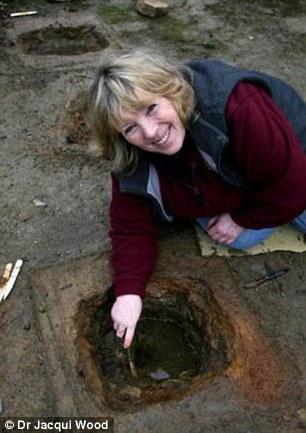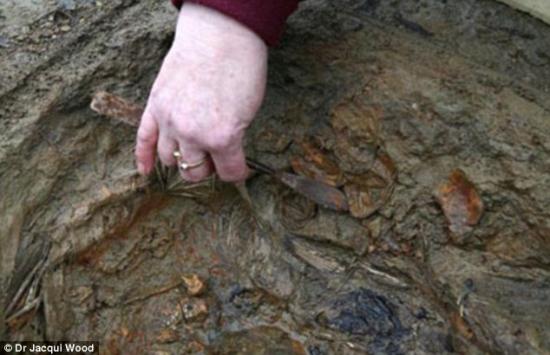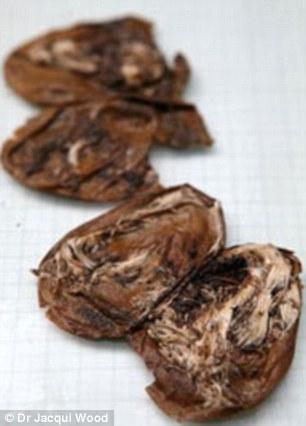Martin Robinson
Source - http://www.dailymail.co.uk/news/article-2889879/Archaeologists-reveal-Cornish-spinsters-using-witch-pits-recently-1970s-claim-practice-alive-today-discovering-scores-lined-swan-feathers-eggs.html?ITO=1490&ns_mchannel=rss&ns_campaign=1490
Who were the modern-day witches of Saveock? Spinster sisters under suspicion after archaeologists find ancient Cornish 'witch pits' were still being used until at least the 1970s
Dr Jacqui Wood has found dozens of witch pits in village of Saveock
-
Rectangular holes linked to bizarre fertility ritual dating back to 1640s
-
Contain animal or bird carcasses, unhatched eggs and pile of pebbles
-
The pits may be an offering to saint of newborn babies to aid fertility
-
Latest hole contains bones wrapped in twine only used since 1970s
-
Dr Wood believes that generations of local women have carried out ritual
-
She said: 'There is an unbroken line from the 1640s to today. I think the people doing it now must still be alive'

Mystery: Archaeologist Dr Jacqui Wood has found dozens of witch pits including one believed to be from the 1970s
A secret coven of Cornish witches first formed in the 1640s has been digging pits lined with animal skins, bird carcasses and feathers as recently as the 1970s as part of a fertility ritual, it was revealed today.
Archaeologist Jacqui Wood has discovered dozens of shallow rectangular holes near the hamlet of Saveock near Truro since 2003.
Locals believe that two spinsters from the village, who died in the 1980s, were members of a coven of local witches who may have links to the pits and passed on their secrets.
The freshest hole contains animal bones wrapped in a synthetic twine only used in Cornwall since the 1970s, which means the witch or witches who dug it are very likely to be alive, she says.
Dr Wood's theory is that generations of local women have slaughtered and skinned animals and birds to help them fall pregnant.
The earliest witch pit dates back to the 1640s and is lined with a slaughtered swan turned inside-out, claws from other birds and a small pile of stones.
In ancient folklore the swan is a symbol of fertility and new life.
Others were lined with the skins of animals like cats and dogs, and many have large numbers of birds eggs buried as the chicks were about to hatch.
Remarkably the pits often contain a pile of pebbles only found at Swanpool beach near Falmouth, which is 15 miles away from Saveock.
Dr Wood believes that the pits may be an offering to St Brigid of Kildare in Ireland, the patron saint of newborn babies, dug by women who were struggling to get pregnant.
Other theories involve witches who wanted to marry and have children.
She told MailOnline: 'It is a faith system dating back at least 350 years and I believe it is linked to witchcraft. It is all still a secret, probably passed down from mother to daughter.

Grim: The pits contain animal carcasses or in this case the wing of a swan and a set of egg. Swans are linked to folklore as symbols of rejuvenation and fertility


Symbols: Many of the holes contain eggs from a variety of birds all with chicks that were about the hatch while others contain the skins of animals and birds feathers, right
'We know that one pit must have been dug in the 1970s. It contained orange baler twine invented in the 1960s and we know this was not used in Cornwall until the 1970s. Carbon dating of another pit shows that it was dug after the 1950s.
'There is an unbroken line from the 1640s to today. I think the people doing it now must still be alive.
'What's amazing is that these people must believe it works otherwise they would not still be doing it. And it is still being kept a secret after all these years.
'My own theory is that maybe if you got married and did not get pregnant in the first year, you might make an offering to St Bride of a feather pit. If you finally got pregnant you had to go back to the pit and take out the contents and burn them and set the spirit of the swan free. If you never got pregnant then the pit remained untouched'.
The 40-or-so pits have been found by Dr Wood and her students in areas where there were reeds.
The first one was found by accident in 2003 during the excavation of a neolithic platform.
At first they believed the hole was a failed attempt to plant a tree but then more digging found several more all roughly measuring 42cm long by 35cm wide and 17cm deep.
Dr Wood believes because the land used is often wet it has helped people dig the holes quickly and hide the reeds allowed them to hide the pits easily.
'Every pit is very different but also remarkably similar. It is always involving fur and feather and often birds eggs where the chicks were ready to be born. There is also a small pile of stones, taken from by the sea 15 miles away', she said.
Some have contained bones and the heads of goats or pigs. One had a scrap of newspaper containing the word Mussolini, who rose to power in the 1920s and was executed in 1945.
The people who dug the pits would also have known they were breaking the law.
The killing of swans has been illegal since the 11th century and witchcraft laws were only scrapped in 1951.
Dr Wood said: 'We finally got a radio carbon date for one of the pits which was around 1640’s. That was the time of the Civil War and a dangerous thing to be doing when Cromwell’s army came to Cornwall as any sort of pagan worship was classed as witchcraft and punishable by death'.
HOW PAGANISM AND WITCHCRAFT DOMINATED CORNWALL FOR CENTURIES AND WAS USED TO CURE ILLNESS, END CURSES AND TELL THE FUTURE
For centuries paganism and witchcraft was part of everyday life in Cornwall and peaked in the 19th century. The majority of communities had their own white witch who was seen as a form of public servant. These witches, also known as pellars, would protect families, get rid of curses and also cure illnesses. Commonly they would also bury offerings on behalf of people, like the pits found in Saveock. The most famous of these was Tamsin Blight, right, who lived from 1798 to 1856 in West Cornwall, and was known to have extraordinary powers to heal sick humans and animals. It was said that she once went to a graveyard and raised the spirit of a recently deceased woman for a male relative who wanted to know about his inheritance. The folk tale known as the 'The Ghost of Stythians' says she used a charmed ring and chanted incantations for some time before people heard a great crashing noise, screams of pain and felt a gust of wind before the woman's spirit rose from the grave and was questioned. One of Cornwall's main tourist attractions is the Museum of Witchcraft in Boscastle, which contains tales of witchcraft and artefacts. Its website sets out various spells and rituals that were used in the county and explained in stories and poems. One called the 'the hand of a suicide' explains how some believed the sick could be cured if they put their hands on the body of a man who had killed themselves. Others believed that touching the body of a person who was recently hanged had the same effect. Another ritual commonly used would involve someone who was ill walking over burning wood from a fire to cure terminal illnesses. One tradition involved the burning of ivy leaves or rushes to find out the future. A couple who wanted to know if they would marry would throw rushes on the fire. If the rushes burned together they would have a happy marriage, but if they split then that would be their fate, Others used two ivy leaves, burying then in ashes, and used the number of cracks that appeared in woman's leaf to predict how many children they would have. The one that burned the longest would live the longest.